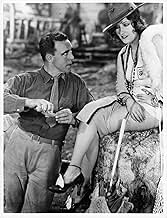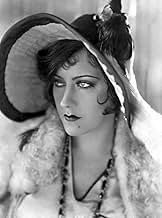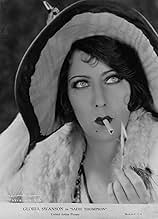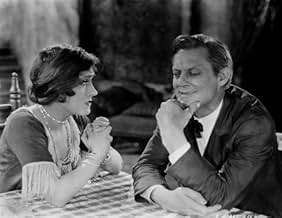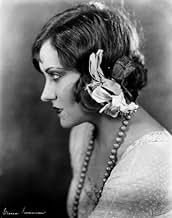CALIFICACIÓN DE IMDb
7.2/10
2.9 k
TU CALIFICACIÓN
Agrega una trama en tu idiomaA prostitute seeking a fresh start becomes the obsession of a religious extremist.A prostitute seeking a fresh start becomes the obsession of a religious extremist.A prostitute seeking a fresh start becomes the obsession of a religious extremist.
- Dirección
- Guionistas
- Elenco
- Nominado a 2 premios Óscar
- 3 premios ganados y 2 nominaciones en total
Charles Sullivan
- Marine
- (sin créditos)
Opiniones destacadas
This was the first version of the W. Somerset Maugham novel "Rain," which was remade in 1932 by the original title and again in 1953 as "Miss Sadie Thompson." Gloria Swanson is amazing in the title role as a prostitute who becomes stranded on the remote Island of Pago Pago. She flirts with a soldier (Raoul Walsh, who was the director), then seduces a respected preacher played by Lionel Barrymore. This certainly can be called one of the "pre-code" films of the 1920s/1930s, before the Hays Code was in effect. For many years the final scenes were lost, so now the restored versions use still photos and new title cards to complete the picture.
For those who would pigeonhole Raoul Walsh as an "action master" or "man's director", this small-focus drama with a female protagonist might seem at odds with his image. In fact, while he was a versatile director who could turn out a rousing action scene, it was the drama particularly in the relationships between individuals that was Walsh's greatest strength. Sadie Thompson in fact shows us his mastery of the technique in its purest form.
Walsh himself made the adaptation from the play "Rain", not as easy a task as it sounds a play has to convey action through dialogue, while a silent film does the exact opposite. Sadie Thompson begins with a series of autograph mottos from each character, a rather clumsy way to introduce character. This is immediately followed however with a particularly smooth bit of film-making. We are given a point-of-view shot, as Swanson looks down at the group of soldiers on the shore, then we cut back to her, and the camera pulls back as she descends the gang plank. A few shots later the camera is dollying forward, following Swanson and the soldiers hovering around her. In this handful of shots we are subtly informed of Miss Thompson's profession, but also with those attention-grabbing point-of-view shots and camera movements we, the audience, are placed into the position of the characters. Walsh has drawn us into the story at this crucial establishing moment.
Considering it only really revolves around two developing relationships that between Sadie and Tim, and that between Sadie and Davidson the main part of the film is like a tour-de-force of different ways to shoot interaction between two people. The scenes between Swanson and Walsh are given the customary tenderness of a regular romance, with some delicate shot compositions that give it a natural, harmonious feel. The relationship between Swanson and Barrymore in contrast is full of intensity lots of cuts, faces framed in stark close-up. What is particularly neat, is that all of the major dialogue scenes begin with a fair few title cards getting the unavoidable wordy bits out of the way first but then the dialogue fizzles out and the interaction continues with just the images, back and forth.
Of course, the effectiveness of the drama would be lost without great acting and, yes, this probably is Swanson's finest performance prior to Sunset Boulevard. I think Swanson was at her best when she was really allowed to let go, and put all her energy into a character, and to say she does that here would be an understatement. Lionel Barrymore is fine as the archetypal repressed Christian, a little hammy perhaps but then, he is a Barrymore. And Walsh himself absolutely acts his socks off, actually turning in the deepest performance of the picture, and the fact that his acting days were soon to be cut short is one of several tragedies regarding his career.
Speaking of tragedies, looming over Sadie Thompson is the unfortunate loss of the final reel, which has since been semi-reconstructed with stills and titles. While what we see today suffers from a very noticeable lack of a climax, the dramatic build up comes close to perfection. Considering its small scale and lack of action, Sadie Thompson was apparently a massive popular success. In his autobiography Raoul Walsh quotes several letters he apparently received from prostitutes of various nationalities which, while they may well have been fabricated or exaggerated slightly, are probably accurate at least in tone. By contrast the 1932 talkie version was a flop, despite an equally great cast, testament to Walsh's talent as a director of powerful cinematic drama.
Walsh himself made the adaptation from the play "Rain", not as easy a task as it sounds a play has to convey action through dialogue, while a silent film does the exact opposite. Sadie Thompson begins with a series of autograph mottos from each character, a rather clumsy way to introduce character. This is immediately followed however with a particularly smooth bit of film-making. We are given a point-of-view shot, as Swanson looks down at the group of soldiers on the shore, then we cut back to her, and the camera pulls back as she descends the gang plank. A few shots later the camera is dollying forward, following Swanson and the soldiers hovering around her. In this handful of shots we are subtly informed of Miss Thompson's profession, but also with those attention-grabbing point-of-view shots and camera movements we, the audience, are placed into the position of the characters. Walsh has drawn us into the story at this crucial establishing moment.
Considering it only really revolves around two developing relationships that between Sadie and Tim, and that between Sadie and Davidson the main part of the film is like a tour-de-force of different ways to shoot interaction between two people. The scenes between Swanson and Walsh are given the customary tenderness of a regular romance, with some delicate shot compositions that give it a natural, harmonious feel. The relationship between Swanson and Barrymore in contrast is full of intensity lots of cuts, faces framed in stark close-up. What is particularly neat, is that all of the major dialogue scenes begin with a fair few title cards getting the unavoidable wordy bits out of the way first but then the dialogue fizzles out and the interaction continues with just the images, back and forth.
Of course, the effectiveness of the drama would be lost without great acting and, yes, this probably is Swanson's finest performance prior to Sunset Boulevard. I think Swanson was at her best when she was really allowed to let go, and put all her energy into a character, and to say she does that here would be an understatement. Lionel Barrymore is fine as the archetypal repressed Christian, a little hammy perhaps but then, he is a Barrymore. And Walsh himself absolutely acts his socks off, actually turning in the deepest performance of the picture, and the fact that his acting days were soon to be cut short is one of several tragedies regarding his career.
Speaking of tragedies, looming over Sadie Thompson is the unfortunate loss of the final reel, which has since been semi-reconstructed with stills and titles. While what we see today suffers from a very noticeable lack of a climax, the dramatic build up comes close to perfection. Considering its small scale and lack of action, Sadie Thompson was apparently a massive popular success. In his autobiography Raoul Walsh quotes several letters he apparently received from prostitutes of various nationalities which, while they may well have been fabricated or exaggerated slightly, are probably accurate at least in tone. By contrast the 1932 talkie version was a flop, despite an equally great cast, testament to Walsh's talent as a director of powerful cinematic drama.
Unfortunately, the final reel of "Sadie Thompson" has been partially lost due to the ravages of time on nitrate stock. Because of this, the final portion often uses stills to fill in the blanks. It's a less than desirable way to do the film, but there simply is no other choice unless a final reel is one day discovered and the film is pieced back together. In addition, some other portions of the film are pretty rough, but not so much that it seriously impacts watching the film.
I have already seen this story two other times, though this is the first time I've seen the silent version. While it's obvious that Gloria Swanson plays a prostitute (Sadie Thompson), like other films of the day, it's strongly implied but they never called her that or said exactly what she was--just that she was a woman of 'ill-repute' or was 'undesirable'. But, unless you are really, really young or really, really naive, it's very clear what the film is implying in this adaptation of the W. Somerset Maugham story.
The story begins with Sadie arriving on the island of Pago-Pago. On board the ship are also some moralistic reformers, the Davidsons (Lionel Barrymore and Blanche Friderici). Unfortunately for Sadie, these reformers seem to spend almost every waking moment worrying about Sadie's sex life and work hard to have her thrown off the island. At first, Sadie is contemptuous of them but later when it looks like they are about to become successful, things change very quickly. Where all this ends up you'll need to see for yourself.
I liked the acting of this film--especially Swanson's. It was rather bawdy yet very restrained (except for when it called for lots of emotion near the end)--and it easily could have been over the top. Also, although the film's in rough shape, what you do see is quite good--with a good reproduction of the tropical locale and nice camera-work. All in all, a very high quality film from start to finish. Too bad about the missing footage.
By the way, Sadie's ruggedly handsome love interest, Sgt. O'Hara, is played by the film's director, Raoul Walsh! He actually gave up acting for directing full-time after he lost an eye in an accident--shortly after completing this film.
I have already seen this story two other times, though this is the first time I've seen the silent version. While it's obvious that Gloria Swanson plays a prostitute (Sadie Thompson), like other films of the day, it's strongly implied but they never called her that or said exactly what she was--just that she was a woman of 'ill-repute' or was 'undesirable'. But, unless you are really, really young or really, really naive, it's very clear what the film is implying in this adaptation of the W. Somerset Maugham story.
The story begins with Sadie arriving on the island of Pago-Pago. On board the ship are also some moralistic reformers, the Davidsons (Lionel Barrymore and Blanche Friderici). Unfortunately for Sadie, these reformers seem to spend almost every waking moment worrying about Sadie's sex life and work hard to have her thrown off the island. At first, Sadie is contemptuous of them but later when it looks like they are about to become successful, things change very quickly. Where all this ends up you'll need to see for yourself.
I liked the acting of this film--especially Swanson's. It was rather bawdy yet very restrained (except for when it called for lots of emotion near the end)--and it easily could have been over the top. Also, although the film's in rough shape, what you do see is quite good--with a good reproduction of the tropical locale and nice camera-work. All in all, a very high quality film from start to finish. Too bad about the missing footage.
By the way, Sadie's ruggedly handsome love interest, Sgt. O'Hara, is played by the film's director, Raoul Walsh! He actually gave up acting for directing full-time after he lost an eye in an accident--shortly after completing this film.
Sadie Thompson (1928) :
Brief Review -
Raoul Walsh's zealous attempt to discover new proportions of human redemption powered by Gloria Swanson's Amazing performance. Walsh was a known name after he made the Magnum Opus 'The Thief Of Bagdad' (1924), before making this film. So it was unlikely to expect another gigantic adventure from him with a female-led film. Sadie Thompson has some issues in the climax, which might have been controversial for that time, but today when I look at the film, I understand his zealousness. Especially in the character played by Lionel Barrymore. It's a Gloria Swanson-led film alright but this character keeps tangling you. One just can't say whether he is a villain or a good soul. The same goes with Sadie's character too. You know she is a prostitute yet you want to see her get reformed. However, one must realise that it's not that easy. You just can't reform yourself just after you have decided, there's a process to test your ability. Sadie Thompson is a well made film in that sense. The way it shows that process and the desperate nature of all three leading actors, but the film gets a little messy and confusing at the end. There could be some valid reasons for that, philosophical or religious ones, but I don't want to get into such conversations. Sadie Thompson tells the story of a "fallen woman" who comes to Pago Pago to start a new life, but encounters a zealous missionary who wants to force her back to her former life. Her love story isn't formed well, too rushed I mean, but okay. The performances of all three leading actors makes it a must watch. Whatever remakes and adaptations are available out there, are not worthy enough. So prefer this first copy. It's no match to Raoul Walsh's best works like 'The Thief Of Bagdad' and 'White Heat', but as good as his 'High Sierra', and better than 'The Roaring Twenties'.
RATING - 7/10*
By - #samthebestest.
Raoul Walsh's zealous attempt to discover new proportions of human redemption powered by Gloria Swanson's Amazing performance. Walsh was a known name after he made the Magnum Opus 'The Thief Of Bagdad' (1924), before making this film. So it was unlikely to expect another gigantic adventure from him with a female-led film. Sadie Thompson has some issues in the climax, which might have been controversial for that time, but today when I look at the film, I understand his zealousness. Especially in the character played by Lionel Barrymore. It's a Gloria Swanson-led film alright but this character keeps tangling you. One just can't say whether he is a villain or a good soul. The same goes with Sadie's character too. You know she is a prostitute yet you want to see her get reformed. However, one must realise that it's not that easy. You just can't reform yourself just after you have decided, there's a process to test your ability. Sadie Thompson is a well made film in that sense. The way it shows that process and the desperate nature of all three leading actors, but the film gets a little messy and confusing at the end. There could be some valid reasons for that, philosophical or religious ones, but I don't want to get into such conversations. Sadie Thompson tells the story of a "fallen woman" who comes to Pago Pago to start a new life, but encounters a zealous missionary who wants to force her back to her former life. Her love story isn't formed well, too rushed I mean, but okay. The performances of all three leading actors makes it a must watch. Whatever remakes and adaptations are available out there, are not worthy enough. So prefer this first copy. It's no match to Raoul Walsh's best works like 'The Thief Of Bagdad' and 'White Heat', but as good as his 'High Sierra', and better than 'The Roaring Twenties'.
RATING - 7/10*
By - #samthebestest.
After watching this silent film i began to realize how large of a roll the music production contributed to the film industry through out America's cinema history. With all the flashy yet realistic effects that are produced now a days its hard to notice what makes a good movie good, and to me a lot of that has to do with the music. The audio of a silent film really helps you understand the language, emotion, and even gestures of a setting for a particular scene. The other portion of this film that i found interesting was the language and slang of the late 1920's. Words like "brazen" "boodwar" "brothel" "scarlet" and even "blood thirsty blizzard" are words were never hear now a days. I guess it just helps with the understanding of the era of silent films.
¿Sabías que…?
- TriviaUnseen for many years because the last reel had decomposed, the final eight minutes have been reconstructed using production stills and title cards, allowing modern audiences to see an approximation of the complete film.
- ErroresAt the beginning of the film, Mr. and Mrs. Davidson each write a quotation in the ship's autograph book. Their handwriting appears identical, revealing that neither actor actually wrote what is shown on screen.
- Citas
Sadie Thompson: [screaming at Alfred Davidson] Was I doing you any harm? You bloodthirsty buzzard! Was I? Who gave you the right to pass judgement on me? You psalm-singing louse! You'd tear out your own mother's heart, if she didn't agree with you, and call it saving her soul!
- Versiones alternativasOriginally released at 97 minutes. Out of circulation for decades because the final reel of the picture was destroyed due to film decay.
- ConexionesEdited into Spisok korabley (2008)
Selecciones populares
Inicia sesión para calificar y agrega a la lista de videos para obtener recomendaciones personalizadas
Detalles
- Fecha de lanzamiento
- País de origen
- Idioma
- También se conoce como
- Ljudska slabost
- Locaciones de filmación
- Two Harbors, Santa Catalina Island, Channel Islands, California, Estados Unidos(some Pago Pago exteriors)
- Productora
- Ver más créditos de la compañía en IMDbPro
Taquilla
- Presupuesto
- USD 650,000 (estimado)
- Tiempo de ejecución1 hora 37 minutos
- Mezcla de sonido
- Relación de aspecto
- 1.33 : 1
Contribuir a esta página
Sugiere una edición o agrega el contenido que falta

Principales brechas de datos
By what name was Sadie Thompson (1928) officially released in Canada in English?
Responda


